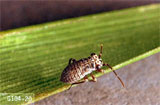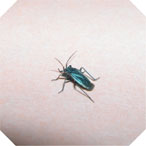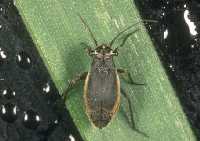| | There is a black bug in my hay and pasture fields, what could it be?
Most likely what you see is the black grass bug (Labops hesperius). The adult black grass bug is about ¼ inch long, black with a whitish-buff colouring around the wing margins and light coloured markings on the head. Another distinguishing feature is that they have bulging eyes on the sides of their heads and are sometimes called big eyed bugs. They are native to western rangelands and are present in low numbers on native range. These bugs have been known to increase in numbers when rangeland is seeded to tame forages.

 | 
 | 
 |

Figure 1 Nymph Black Grass Bug (Labops hesperius)
Photo Credit: Ken Gray, Oregon State University | 
Figure 2 Adult Black Grass Bug (Labops hesperius)
Photo Credit: Kim Zeleny, Ag-Info Centre
Alberta Agriculture | 
Figure 3 Black grass bug
Phote Credit: Hammon, R.W. and Peairs, F.B. 2001 |
How are the plants damaged?
Black grass bugs pierce the plant cell walls and suck out the liquid cell contents. The leaves will have whitish spots starting at the leaf tip, the bugs proceed down the leaf feeding with their head pointing downwards. Most of the feeding occurs on the upper part of the leaves and the plants look like they have been damaged by frost.
Will the plants recover?
Most of the damaged plants will recover with adequate moisture, but with drought conditions and with a severe infestation, the damage may be irreversible. As with any plant disease or pest infestation, healthier plants can withstand more damage and recover more quickly.
What crops do they feed on and will they move into my other fields?
Black grass bugs feed primarily on grasses, with wheatgrasses being preferred, but when no grasses are present they will feed on broadleaf plants. In a study conducted in Utah, researchers found that black grass bugs prefer tame grasses over native forages. Of the six tame grasses they tested, the following list is ranked from the most to least susceptible: Intermediate wheatgrass, Kentucky bluegrass, Slender wheatgrass, orchard grass, smooth bromegrass, mountain bromegrass and native grass.
Infestations are generally due to existing populations of black grass bugs and they do not disperse from other areas. They may move into adjacent fields, but movement is usually limited to field edges. One of the main reasons why these bugs do not move too far is that the majority of the females do not have fully developed wings.
What is the life cycle of these bugs?
The adults lay eggs in the stems of host plants. As the plants begin to grow the eggs hatch. Black grass bugs only have one generation per year and the nymphs feed and molt five times before they become adults. It generally takes four to five weeks from hatching for them to become adults. Bug numbers will decline in about four weeks after the adult insects appear, as adults lay eggs they die. Temperature will affect the length of time the insects are present in the field, they will mature more quickly at higher temperatures.
How do you control black grass bugs?
In Canada, an economic threshold has not been established for black grass bugs, and no insecticides are registered for controlling this insect. In the United States, both Malathion™ and Sevin™ have been used to control black grass bugs, but in many instances spraying hay and pastureland was not economical.
Other methods of control include, grazing or haying fields late in the fall to remove eggs and reduce the infestation level. Forage seed producers can be more affected because they cannot harvest as early as hay production fields.
References used:
Hammon, R.W. and Peairs, F.B. 2001. Black grass bugs. Colorado State University Co-operative Extension, No. 5.575
Higgins, K.M., Browns, J.E. and Haws, A.B. 1977. The black grass bug (Labops hesperious Uhler): Its effect on several native and introduced grasses. J. Range Manage. 30(5):380-384.
Campbell, J.B. 2002. Big eyed or black grass bugs. Range and Pasture XIX-5
Black grass bugs Colorado State
Prepared by Ag-Info Centre, Alberta Agriculture & Forestry |
|